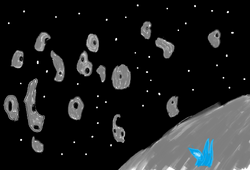| Cane Cluster | |
|---|---|
 | |
| Astrography | |
| Star | Wight |
| Type | Asteroid Field |
| Satellites | N/A |
| Gravity | N/A |
| Orbital distance | 3.8 AU |
| Day length | N/A |
| Year length | N/A |
| Diameter | 3.8 AU |
| Axial tilt | N/A |
| Temperature | |
| Average | -100 ° C |
| Minimum | -110 ° C |
| Maximum | -90 ° C |
| Atmosphere | |
| Atmosphere composition | 90% carbon-dioxide, 10% other gases |
| Surface pressure | .001 atms |
| Demographics | |
| Factions | Ornothosians, Humans |
| Population | 20,000 |
| Major imports | Food, research materials |
| Major exports | Research, metals, crystal beings |
The Cane Cluster is a large cloud of dust and asteroids that surrounds the Neplixeme system. It is home to two research stations, Grey Hole and Surrbrrkan. It is also home to strange, molten, crystal beings.
Orbit[]
The Cane Cluster orbits the F-class star Wight at about 3.8 AU. It is composed of large chunks of rock and ice, interspersed with clouds of dust and gas. Most objects in the cluster vary in size from 3-feet to 3000-feet in diameter. The largest rock in the entire cluster is a dwarf planet called Nerrbac, which is about 30,000-feet in diameter. The cluster is thickest celestial south-west from Wight. This is likely because the Cluster was formed when a large planet was destroyed in that area.
Geography[]
As mentioned above, the Cane Cluster is a large asteroid field, and as such has an amorphous geography. The asteroids often collide with one another, and many leave their orbit altogether. There are only three static features in the entire cluster: the human research facility of Grey hole, the Ornothosian research facility and shipyard of Surrbrrkan, and Nerrbac, a slowly orbiting dwarf planet.
Ecosystem[]
The Cluster is home to a unique kingdom of animals, classified by humans as Populi terracaelo. The 'terracaels" are a group colonial beings that keep themselves hidden inside crystal shells, with each unit of the terracael taking on a certain role. They use the miniscule amounts of oxygen and carbon in their surroundings to maintain life functions, but almost never move. But when the resouces in their immediate surrounding begin to grow low, the terracaels move. This ambulation is a spectacular sight. Terracaels use almost none of the nutrients they take in, instead stockpiling them. When it needs to move, a terracael uses this stockpile to selectivly release high energy pulses, turning parts- joints, if you will-of its crystal shell molten. It then moves the newly created limbs forward, and begins walking to a new area.
Other than large farming and oxygen creation domes, the only other life forms in the Cluster are extremeophile bacteria.
Fauna[]
- Terracaels - Colonial animals. Live inside crystal shells of variable composition.
- Safier - Large, blue, round terracael, most mobile of the kingdom. Acts as one of the few terracael predators, and has advanced electromagnetic sensory organs for hunting other terracaels.
- Rubles - Red, sharp-shelled terracael. Uses stockpiled energy to jet to new, resource rich asteroids. Launches small crystals to gain trajetory information.
- Smoka - Restricted to high resouce asteroids. Cloudy-gray terracael. Wide, dome-shaped shell with mouth on the bottom, which is used to slowly eat a hole through inhabited asteroid. Only moves when it has gone completely through.
- Barkel - Semi-predatory terracael. Uses stored energy to send seismic pulses into surrounding ground to find food sources.